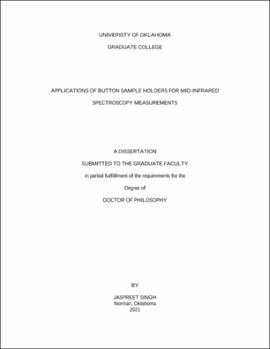| dc.contributor.advisor | White, Robert | |
| dc.contributor.author | Singh, Jaspreet | |
| dc.date.accessioned | 2021-12-20T20:56:26Z | |
| dc.date.available | 2021-12-20T20:56:26Z | |
| dc.date.issued | 2021-12-17 | |
| dc.identifier.uri | https://hdl.handle.net/11244/332506 | |
| dc.description.abstract | Infrared (IR) spectroscopy is a rapid and non-destructive method for chemical analysis that is based on interactions between electromagnetic radiation and matter. Despite its widespread popularity in commercial and research environments, there have been no major developments in IR sampling methods since the 1960’s. This dissertation describes applications of a new mid-IR spectroscopy sampling method that involves the use of a unique “button” sample holder. Buttons are fabricated from stainless-steel and comprise a backing to which a wire mesh is attached. This type of sample holder can accommodate thin layers of neat solid or liquid samples, eliminating the need for time-consuming and expensive sample dilution protocols. Because infrared radiation reflects from button surfaces over a wide range of angles, diffuse reflection optics are needed to collect the radiation after it interacts with the sample. The small wire diameters characteristic of the meshes used to construct buttons allow thin sample layers to be analyzed. Path lengths on the order of a few microns can be achieved, permitting analysis of high absorptivity neat samples, such as coals, that would otherwise need to be diluted in a non-absorbing sample matrix. The unique mechanism by which radiation interacts with samples produces spectra with greatly enhanced dynamic range when compared to conventional methods.
The unconventional buttons sample holder can be employed for quantitative analyses of both solids and liquids, yielding linear calibration curves. A modified button containing a sample reservoir can be utilized as a variable path length liquid cell, with path lengths determined by the sample volume. Although path lengths are not directly proportional to sample volume, quantitative liquid sample analyses can be achieved when the effective path length is constant, which requires that constant sample volumes are added to the reservoir. The robust button design permits abrasive sampling by simply rubbing the rough button mesh over sample surfaces to remove small quantities of material. This approach was used to obtain infrared spectra of commercial pharmaceutical tablets quickly and easily. The sensitivity and reproducibility of this methodology was sufficient for product discrimination by principal component analysis (PCA).
The utility of the button sample holder was extended by constructing several unique accessories. An eight-sample carousel was built to allow multiple samples to be analyzed with minimal effort. A low-temperature thermoelectric cooling accessory was constructed to rapidly cool and heat button samples. By using this device, infrared spectra at sub-ambient temperatures were obtained. This apparatus was also useful for measuring infrared spectra of highly volatile samples. By using a temperature controller, unique temperature ramp profiles were applied to solid samples to discriminate between reversible and irreversible sample changes. A button sample holder was incorporated into a variable temperature diffuse reflectance infrared Fourier transform (VT-DRIFTS) apparatus to investigate molecular level processes occurring during zeolite dehydrations. Subtle, temperature-dependent changes in cation-exchanged Linde Type A (LTA) and NaY zeolites were identified and characterized. By using spectral subtractions, sodium-LTA dehydration was found to occur by a step-wise mechanism involving temperature-dependent changes in water-cation interactions. A VT-DRIFTS study of calcium-exchanged LTA identified a complex sequence of concurrent processes, which included the formation of carbonate species. For NaY zeolite, VT-DRIFTS difference spectroscopy was used to selectively monitor changes in the hydroxyl groups contained in water and attached to zeolite framework acid sites. | en_US |
| dc.language | en_US | en_US |
| dc.rights | Attribution-NonCommercial-ShareAlike 4.0 International | * |
| dc.rights.uri | https://creativecommons.org/licenses/by-nc-sa/4.0/ | * |
| dc.subject | Diffuse Reflectance | en_US |
| dc.subject | Fourier Transform Infrared Spectroscopy | en_US |
| dc.subject | Button-IR | en_US |
| dc.subject | Chemistry, Analytical. | en_US |
| dc.title | Applications of Button Sample Holders for Mid-Infrared Spectroscopy Measurements | en_US |
| dc.contributor.committeeMember | Nanny, Mark | |
| dc.contributor.committeeMember | Rice, Charles | |
| dc.contributor.committeeMember | Wu, Si | |
| dc.contributor.committeeMember | Yip, Wai-Tak | |
| dc.date.manuscript | 2021-12 | |
| dc.thesis.degree | Ph.D. | en_US |
| ou.group | College of Arts and Sciences::Department of Chemistry and Biochemistry | en_US |
| shareok.orcid | 0000-0003-0121-0264 | en_US |

